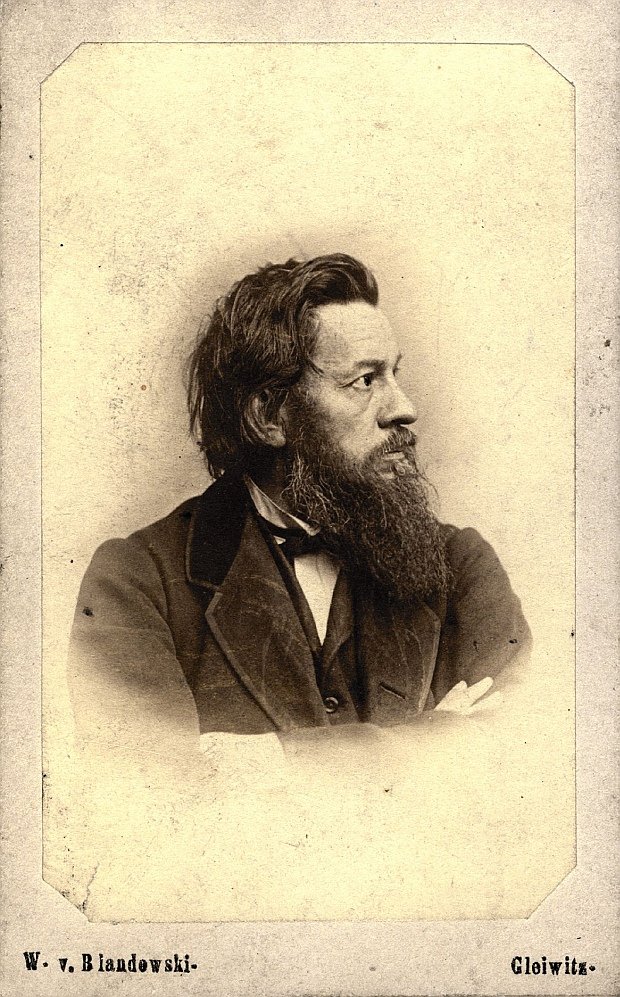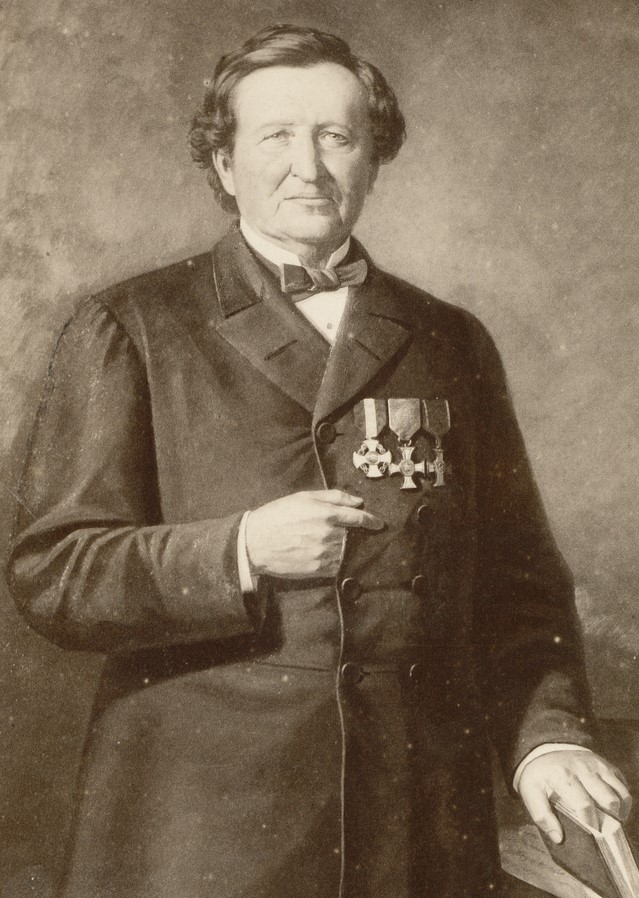|
William Blandowski
Johann Wilhelm Theodor Ludwig von Blandowski, known as William Blandowski (21 January 1822 – 18 December 1878), was a German explorer, soldier, zoologist and mining engineer of Polish roots, he is most famous for his exploration of the Murray and Darling Rivers in Australia. Early life Blandowski was born in Gleiwitz, Upper Silesia, Kingdom of Prussia (now Gliwice, Poland) on 21 January 1822. The youngest of thirteen children his parents, Johann Felix von Blandowski and Leopoldine Gottliebe von Woyrsch were Protestants, and members of the minor Polish aristocracy, using the Wieniawa coat-of-arms. He was educated at the Gymnasium in Lauban but left without gaining his Abitur certificate. He went on to study at the Tarnowitz Mining School and the University of Berlin. Blandowski's education was impacted by the death of his father, financial hardships, and controversies which resulted in quiet expulsions from various institutes. After completing his education, he was employed as ... [...More Info...] [...Related Items...] OR: [Wikipedia] [Google] [Baidu] |
Zoologist
Zoology ()The pronunciation of zoology as is usually regarded as nonstandard, though it is not uncommon. is the branch of biology that studies the Animal, animal kingdom, including the anatomy, structure, embryology, evolution, Biological classification, classification, Ethology, habits, and distribution of all animals, both living and extinction, extinct, and how they interact with their ecosystems. The term is derived from Ancient Greek , ('animal'), and , ('knowledge', 'study'). Although humans have always been interested in the natural history of the animals they saw around them, and made use of this knowledge to domesticate certain species, the formal study of zoology can be said to have originated with Aristotle. He viewed animals as living organisms, studied their structure and development, and considered their adaptations to their surroundings and the function of their parts. The Greek physician Galen studied human anatomy and was one of the greatest surgeons of the a ... [...More Info...] [...Related Items...] OR: [Wikipedia] [Google] [Baidu] |
Moritz Richard Schomburgk
Moritz Richard Schomburgk (5 October 1811 – 24 March 1891), generally known as Richard Schomburgk, was a German botanist and curator of the Adelaide Botanic Garden. Family Schomburgk was born in Freyburg, Saxony, the son of Johann Friedrich Ludwig Schomburgk (a Lutheran minister in Thuringia), and his wife Christiane Juliane Wilhelmine (née Krippendorf). He married Pauline Henriette Kneib (c. 1822 – 24 July 1879) at sea aboard ''Princess Louise''. Among their children were: *Otto Schomburgk (c. 1858 – 1 September 1938), who held several important posts such as Chief Probation Officer with the South Australian public service. He married Ada Louise Downer, daughter of Henry Downer * Eldest daughter Marie Caroline Schomburgk married widower Rev James Sunter in Sydney on 28 May 1894. His older brother, Sir Robert Hermann Schomburgk (5 June 1804 – 11 March 1865), carried out geographical, ethnological and botanical studies in South America and the West Indies (in which Sch ... [...More Info...] [...Related Items...] OR: [Wikipedia] [Google] [Baidu] |
Philosophical Institute Of Victoria
The Philosophical Institute of Victoria was a scientific institute functioned in Victoria, Australia during 19th century. It was founded in 1854 through the amalgamation of the Victorian Institute for the Advancement of Science and the Philosophical Society of Victoria. The first meeting of the newly amalgamated group was held on 10 July 1855 at the Museum of Natural History, chaired by a representative of the Victorian Institute, Dr J. Maund. According to the amalgamation statement, 'the objects of the Philosophical Institute shall be the same as that of the Philosophical Society, and that the mode of operation of the new Institute shall be the same as that of the old Society'. The inaugural president was the Victorian Surveyor General Captain Andrew Clark. Papers read at the first meeting included: * 'On the physical character of the County of Heytesbury'. By Robert Scott. * 'On the favourable geological and chemical nature of the principal rocks and soils of Victoria, in referen ... [...More Info...] [...Related Items...] OR: [Wikipedia] [Google] [Baidu] |
Museum Victoria
Museums Victoria is an organisation which operates three major state-owned museums in Melbourne, Victoria: the Melbourne Museum, the Immigration Museum and Scienceworks Museum. It also manages the Royal Exhibition Building and a storage facility in Melbourne's City of Moreland. History The museum traces its history back to the establishment of the "Museum of Natural and Economic Geology" by the Government of Victoria, William Blandowski and others in 1854. The Library, Museums and National Gallery Act 1869 incorporated the Museums with the Public Library and the National Gallery of Victoria; but this administrative connection was severed in 1944 when the Public Library, National Gallery and Museums Act came into force, and they became four separate institutions once again. Museums Victoria was founded in its current form under the Australian Museums Act (1983). Currently, Museums Victoria's State Collections holds over 17 million items, including objects relating to In ... [...More Info...] [...Related Items...] OR: [Wikipedia] [Google] [Baidu] |
Christchurch
Christchurch ( ; mi, Ōtautahi) is the largest city in the South Island of New Zealand and the seat of the Canterbury Region. Christchurch lies on the South Island's east coast, just north of Banks Peninsula on Pegasus Bay. The Avon River / Ōtākaro flows through the centre of the city, with an urban park along its banks. The city's territorial authority population is people, and includes a number of smaller urban areas as well as rural areas. The population of the urban area is people. Christchurch is the second-largest city by urban area population in New Zealand, after Auckland. It is the major urban area of an emerging sub-region known informally as Greater Christchurch. Notable smaller urban areas within this sub-region include Rangiora and Kaiapoi in Waimakariri District, north of the Waimakariri River, and Rolleston and Lincoln in Selwyn District to the south. The first inhabitants migrated to the area sometime between 1000 and 1250 AD. They hunted moa, which led ... [...More Info...] [...Related Items...] OR: [Wikipedia] [Google] [Baidu] |
Canterbury Museum, Christchurch
The Canterbury Museum is a museum located in the central city of Christchurch, New Zealand, in the city's Cultural Precinct. The museum was established in 1867 with Julius von Haast – whose collection formed its core – as its first director. The building is registered as a "Historic Place – Category I" by Heritage New Zealand. Directors The title curator and director has been used interchangeably during the history of Canterbury Museum. Von Haast was the museum's inaugural director; Haast died in 1887. Following Haast's death, Frederick Hutton was acting director until Henry Ogg Forbes took on a permanent position in December 1888 upon his return from England. In August 1892, Forbes permanently moved to England, and Hutton was appointed full director from May 1892 until October 1905. Hutton applied for leave to travel to England, and Charles Chilton was acting director from March 1905; Hutton died on his return journey from England and Chilton retained his acting role un ... [...More Info...] [...Related Items...] OR: [Wikipedia] [Google] [Baidu] |
Julius Von Haast
Sir Johann Franz Julius von Haast (1 May 1822 – 16 August 1887) was a German-born New Zealand explorer, geologist, and founder of the Canterbury Museum in Christchurch. Early life Johann Franz Julius Haast was born on 1 May 1822 in Bonn, a town in the Kingdom of Prussia, to a merchant and his wife. As a child, he attended a local school but was also educated at a grammar school in Cologne. After completing his formal schooling, he then entered the University of Bonn, where he studied geology and mineralogy. However, he did not graduate. As a young man, he travelled throughout Europe before basing himself in Frankfurt, working in the trading of books and mineral samples collected on his journeys. On 26 October 1846, Haast married Antonia Schmitt at Frankfurt, Germany. The marriage, although unhappy, produced a son named Robert two years later. Haast was fluent in English and, in 1858, was contracted by a British shipping firm, A. Willis, Gann & Company, to report on the ... [...More Info...] [...Related Items...] OR: [Wikipedia] [Google] [Baidu] |
Carl Wilhelmi
Johann Freiderich Carl Wilhelmi (1829–1884) was a Dresden born seedsman who made large collections of botanical specimens in southern Australia. Wilhelmi was one of a number of influential German-speaking residents such as Ludwig Becker (explorer), Ludwig Becker, Hermann Beckler, William Blandowski, Amalie Dietrich, Wilhelm Haacke, Diedrich Henne, Gerard Krefft, Johann George Luehmann, Johann Luehmann, Johann Menge, Carl Muecke (editor), Carl Mücke (a.k.a. Muecke), Ludwig Preiss, Carl Ludwig Christian Rümker, Carl Ludwig Christian Rümker (a.k.a. Ruemker), Moritz Richard Schomburgk, Richard Semon, Richard Wolfgang Semon, Karl Theodor Staiger, George Henry Frederick Ulrich, George Ulrich, Eugene von Guerard, Eugene von Guérard, Robert J. Lendlmayer von Lendenfeld, Robert von Lendenfeld, Ferdinand von Mueller, and Georg von Neumayer who brought their "epistemic traditions" to Australia, and not only became "deeply entangled with the Australian colonial project", but also were "i ... [...More Info...] [...Related Items...] OR: [Wikipedia] [Google] [Baidu] |
Georg Von Neumayer
Georg Balthazar von Neumayer (21 June 1826 – 24 May 1909), was a German polar explorer and scientist who was a proponent of the idea of international cooperation for meteorology and scientific observation. Biography Early years Born in Kirchheimbolanden, Palatinate, Neumayer finished his education in geophysics and hydrography in Munich, Bavaria in 1849; and becoming much interested in polar exploration, continued his studies in terrestrial magnetism, oceanography, navigation, and nautical astronomy. To obtain practical experience he made a voyage to South America, and after his return gave a series of lectures at Hamburg on Maury's theories of the ocean, and recent improvements in navigation. He then decided to go to Australia, shipped as a sailor before the mast, and arrived at Sydney in 1852. Australia von Neumayer was one of a number of influential German-speaking residents such as William Blandowski, Ludwig Becker, Hermann Beckler, Amalie Dietrich, Diedrich ... [...More Info...] [...Related Items...] OR: [Wikipedia] [Google] [Baidu] |
Ferdinand Von Mueller
Baron Sir Ferdinand Jacob Heinrich von Mueller, (german: Müller; 30 June 1825 – 10 October 1896) was a German-Australian physician, geographer, and most notably, a botanist. He was appointed government botanist for the then colony of Victoria (Australia) by Governor Charles La Trobe in 1853, and later director of the Royal Botanic Gardens, Melbourne. He also founded the National Herbarium of Victoria. He named many Australian plants. Early life Mueller was born at Rostock, in the Grand Duchy of Mecklenburg-Schwerin. After the early death of his parents, Frederick and Louisa, his grandparents gave him a good education in Tönning, Schleswig. Apprenticed to a chemist at the age of 15, he passed his pharmaceutical examinations and studied botany under Professor Ernst Ferdinand Nolte (1791–1875) at Kiel University. In 1847, he received his degree of Doctor of Philosophy from Kiel for a thesis on the plants of the southern regions of Schleswig. Mueller's sister Bertha had be ... [...More Info...] [...Related Items...] OR: [Wikipedia] [Google] [Baidu] |
Robert J
The name Robert is an ancient Germanic given name, from Proto-Germanic "fame" and "bright" (''Hrōþiberhtaz''). Compare Old Dutch ''Robrecht'' and Old High German ''Hrodebert'' (a compound of '' Hruod'' ( non, Hróðr) "fame, glory, honour, praise, renown" and ''berht'' "bright, light, shining"). It is the second most frequently used given name of ancient Germanic origin. It is also in use as a surname. Another commonly used form of the name is Rupert. After becoming widely used in Continental Europe it entered England in its Old French form ''Robert'', where an Old English cognate form (''Hrēodbēorht'', ''Hrodberht'', ''Hrēodbēorð'', ''Hrœdbœrð'', ''Hrœdberð'', ''Hrōðberχtŕ'') had existed before the Norman Conquest. The feminine version is Roberta. The Italian, Portuguese, and Spanish form is Roberto. Robert is also a common name in many Germanic languages, including English, German, Dutch, Norwegian, Swedish, Scots, Danish, and Icelandic. It can be use ... [...More Info...] [...Related Items...] OR: [Wikipedia] [Google] [Baidu] |






